The modern conference room has evolved far beyond simple meeting spaces into dynamic environments that shape how teams collaborate, innovate, and communicate. Today's workplace demands conference rooms that seamlessly blend functionality with inspiring design, creating spaces where productivity thrives and creativity flourishes. Whether you're designing a small huddle room for quick brainstorming sessions or a large boardroom for executive meetings, the right design approach can transform mundane meetings into engaging collaborative experiences. From biophilic elements that connect teams with nature to cutting-edge technology that supports hybrid work, contemporary conference room design encompasses diverse styles and features that cater to different meeting types and organizational cultures. Smart acoustic solutions ensure clear communication, while flexible layouts accommodate various group sizes and meeting formats. These carefully crafted spaces reflect company values, enhance employee well-being, and leave lasting impressions on clients and stakeholders who experience them firsthand.
1. Modern Minimalist Conference Room Design
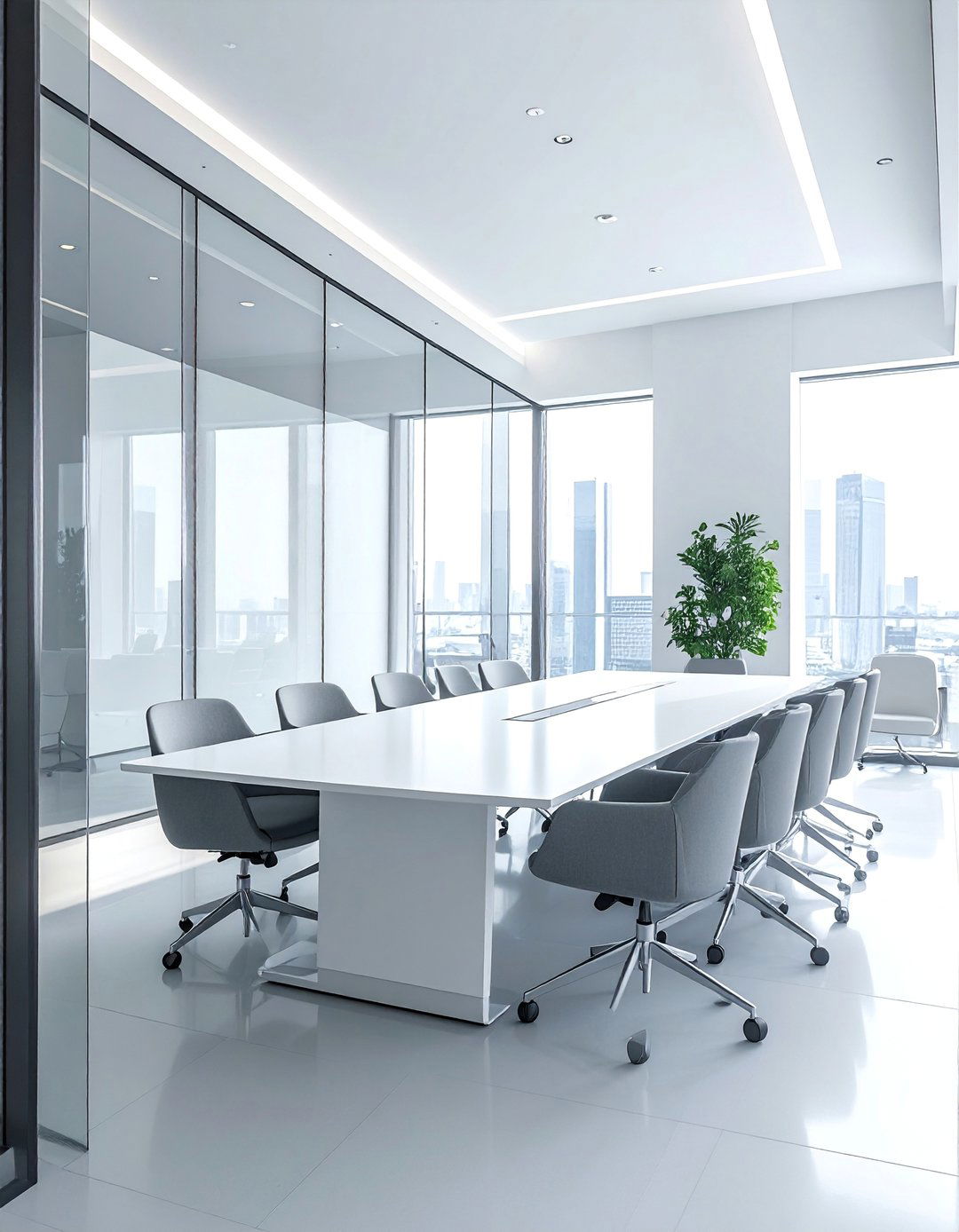
Could your next breakthrough idea emerge from a space that embraces simplicity and clarity? Clean lines, neutral color palettes, and uncluttered surfaces define modern minimalist conference rooms that promote focused thinking and productive discussions. These spaces feature sleek rectangular tables in white or light wood tones, paired with ergonomic chairs in neutral colors like gray or black. Large windows flood the room with natural light, while strategic LED lighting provides consistent illumination throughout the day. Built-in storage solutions keep technology cables hidden, maintaining the clean aesthetic that reduces visual distractions. Glass partitions or walls create transparency while defining the space, and minimal artwork or a single statement piece serves as the only decorative element. This design approach works particularly well for technology companies, consulting firms, and organizations that value efficiency and precision in their business operations.
2. Biophilic Conference Room with Living Elements
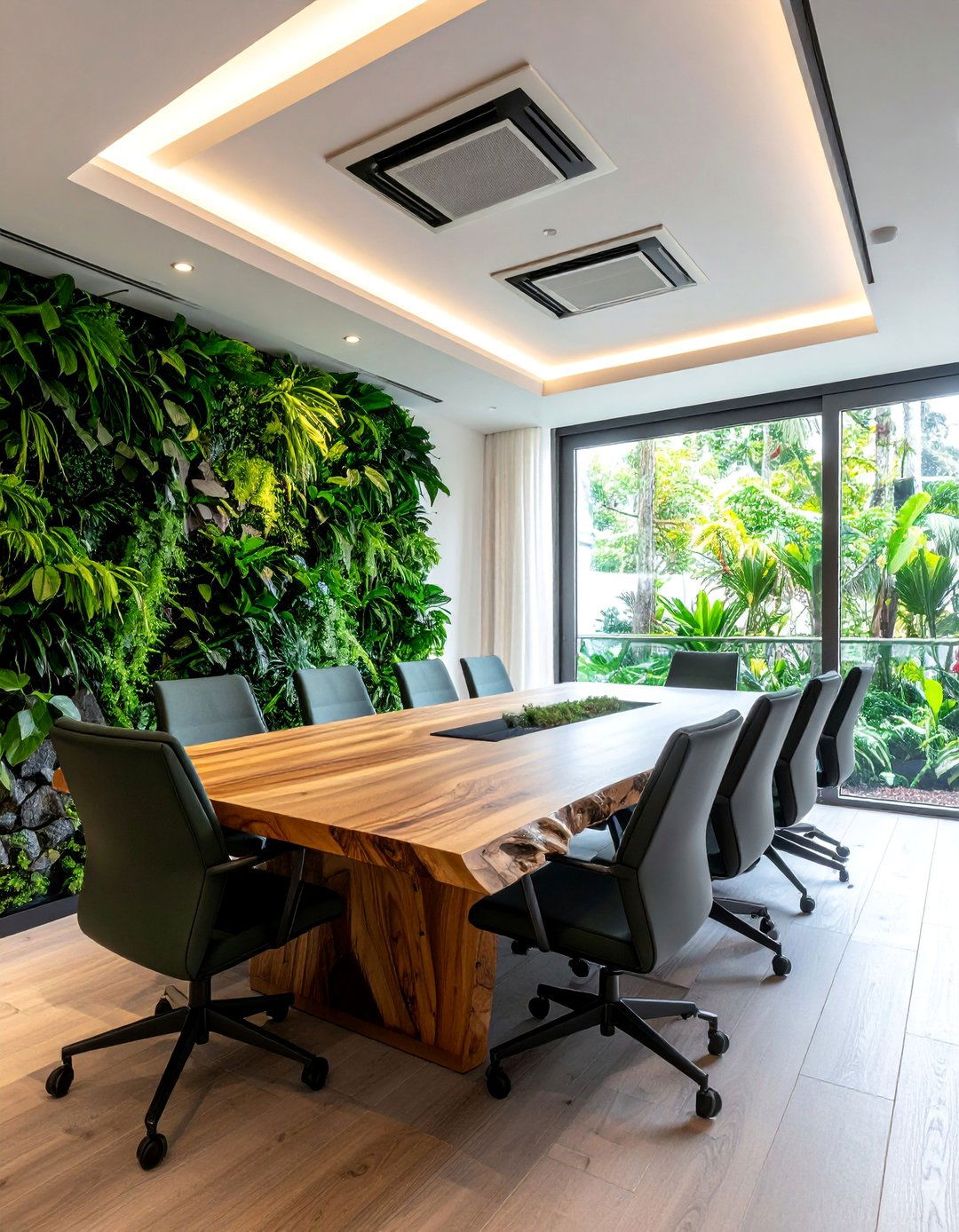
What happens when nature becomes an integral part of your meeting environment? Biophilic conference rooms incorporate living plants, natural materials, and organic shapes to create calming spaces that reduce stress and enhance creativity. Living walls filled with greenery serve as stunning focal points while improving air quality, and natural wood tables bring warmth and texture to the space. Stone or timber accent walls complement the organic theme, while large windows provide views of outdoor landscapes when possible. Indoor plants of varying sizes create layers of greenery throughout the room, from tall floor plants in corners to smaller tabletop arrangements. Natural color schemes featuring earth tones, greens, and warm browns establish a connection to the outdoors. Water features like small fountains or aquariums add soothing sounds that mask background noise and create a tranquil atmosphere perfect for thoughtful discussions and collaborative problem-solving sessions.
3. High-Tech Smart Conference Room Solutions

Why settle for standard meeting rooms when technology can transform every interaction? Smart conference rooms integrate advanced technology seamlessly into the design, featuring interactive whiteboards, wireless presentation systems, and automated environmental controls. Voice-activated assistants manage lighting, temperature, and audio-visual equipment with simple commands, while high-definition displays support both in-person presentations and video conferencing. Wireless charging stations built into the conference table keep devices powered without cable clutter, and advanced camera systems with AI tracking ensure remote participants feel fully engaged. Acoustic sensors automatically adjust sound levels and background noise cancellation, while smart glass windows provide instant privacy control. These rooms often feature modular furniture with integrated technology ports, allowing easy reconfiguration for different meeting types. The design emphasizes clean lines and neutral colors to keep focus on the technology features that enable seamless collaboration between on-site and remote team members.
4. Flexible Modular Conference Room Layout

Are your meeting spaces ready to adapt to whatever your team needs today? Modular conference rooms feature moveable furniture and reconfigurable elements that transform spaces instantly for different meeting types and group sizes. Rolling tables and stackable chairs allow quick transitions from boardroom setups to workshop configurations, while mobile whiteboards and presentation screens move wherever needed. Moveable partition walls create smaller breakout spaces or open up for larger gatherings, and modular seating pods can be arranged in circles for brainstorming or linear setups for presentations. Storage units on wheels hold supplies and equipment while doubling as room dividers when positioned strategically. The flooring design uses carpet tiles or raised access flooring that accommodates changing technology needs and furniture arrangements. Color-coded furniture and accessories help teams quickly identify and arrange elements for specific meeting types, making space transitions efficient and intuitive for all users.
5. Industrial Style Conference Room Design
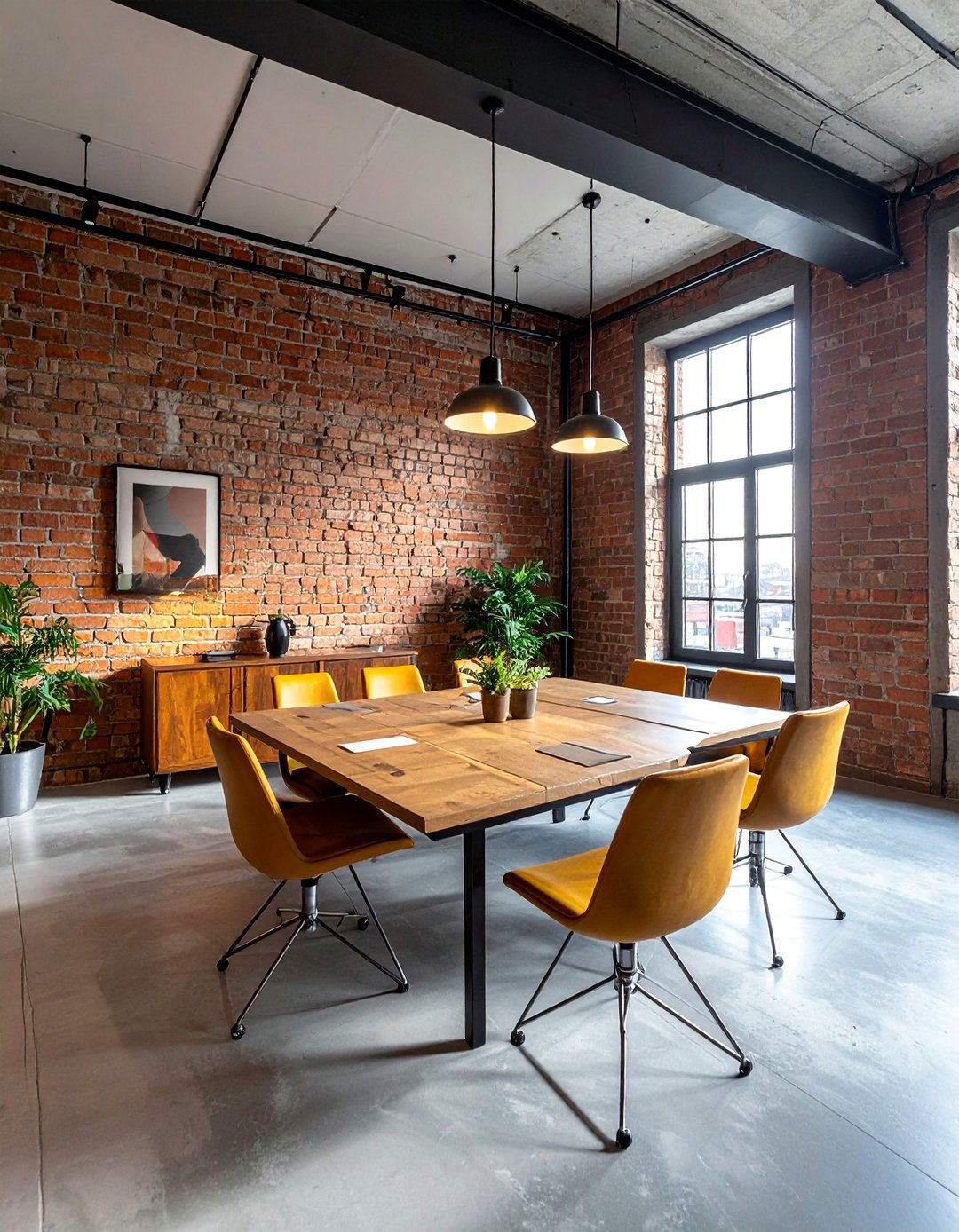
Can raw materials and exposed elements create sophisticated meeting environments? Industrial-style conference rooms celebrate the beauty of unfinished materials and architectural elements, featuring exposed brick walls, concrete surfaces, and visible steel beams. Reclaimed wood conference tables paired with metal frame chairs create striking contrasts between warm and cool materials, while pendant lighting with Edison bulbs or metal fixtures provides ambient illumination. Polished concrete floors or dark hardwood flooring establish the industrial foundation, and large factory-style windows with black frames flood the space with natural light. Pipe shelving and metal storage units serve both functional and aesthetic purposes, while acoustic panels disguised as industrial art help control sound levels. The color palette emphasizes grays, blacks, browns, and metallic accents that complement the raw materials. This design appeals to creative agencies, tech startups, and companies that want to project innovation and authenticity in their corporate identity.
6. Small Huddle Room Conference Setup
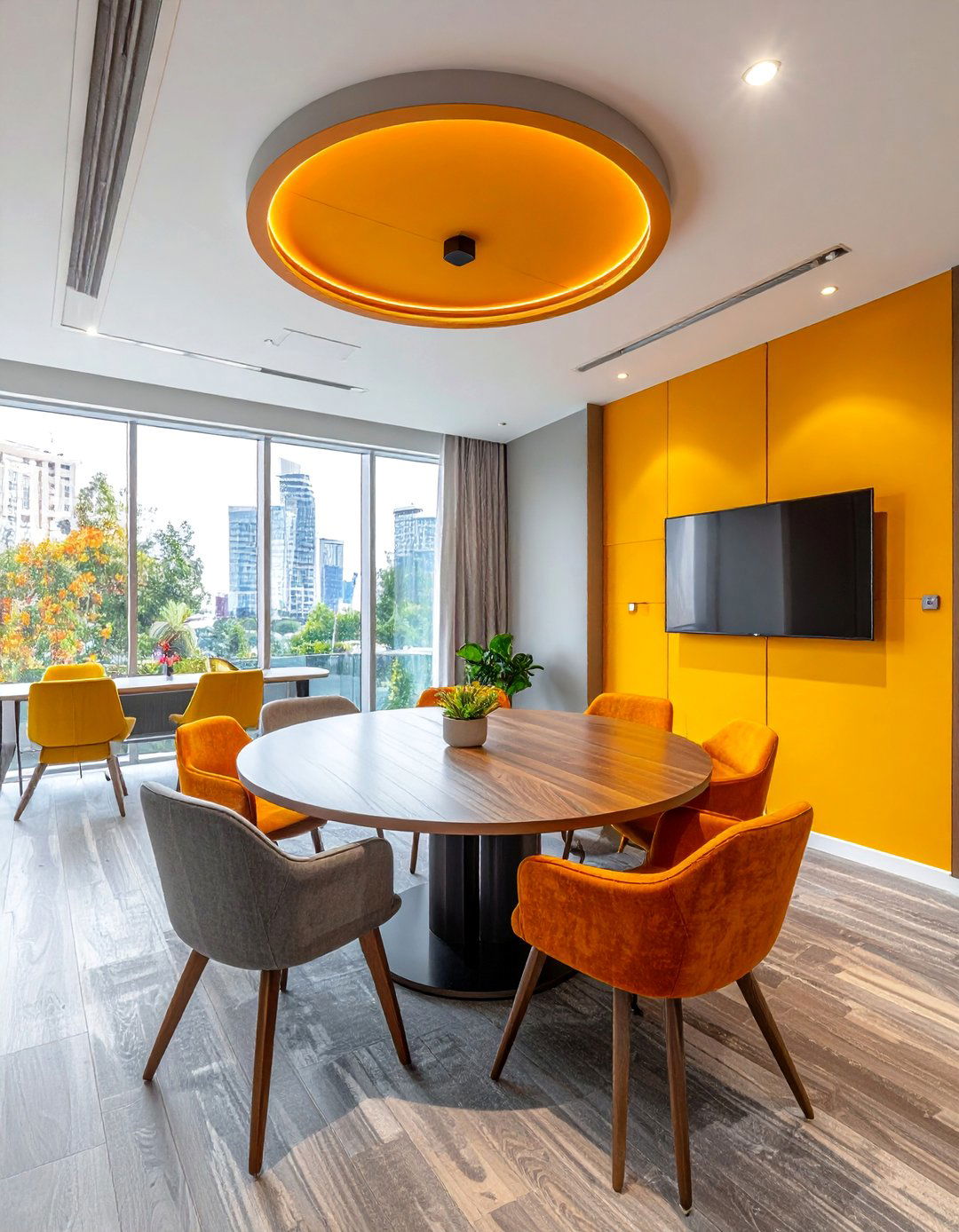
How much collaboration can happen in just 150 square feet? Small huddle rooms maximize limited space while providing intimate settings for quick meetings, phone calls, and focused discussions between two to six people. Round or oval tables encourage equal participation and eye contact, while comfortable lounge chairs or compact task chairs provide seating without overwhelming the space. Wall-mounted displays eliminate the need for floor space while supporting presentations and video calls, and built-in storage keeps the room organized and clutter-free. Acoustic treatment through sound-absorbing panels or fabric wall coverings ensures privacy and reduces distractions from nearby open office areas. Bright lighting and light color schemes make small spaces feel larger and more welcoming, while plants or artwork add personality without consuming valuable real estate. These rooms often feature glass walls or doors to maintain visual connection with the broader workspace while providing necessary acoustic separation for confidential conversations.
7. Executive Boardroom Design Elements
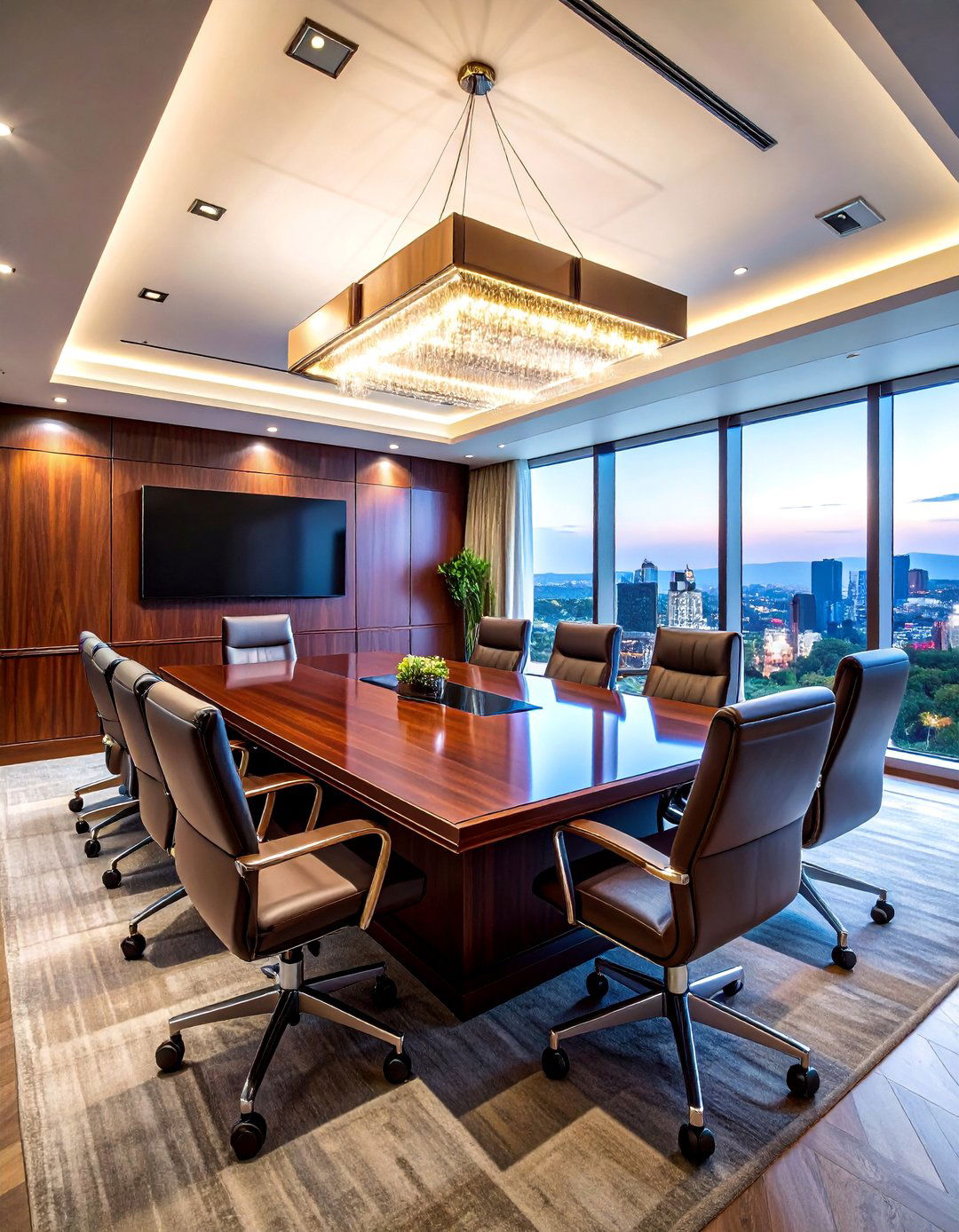
What design elements command respect while inspiring confident decision-making? Executive boardrooms combine luxury materials, sophisticated furnishings, and prestigious details that reflect organizational leadership and success. Large wooden conference tables in mahogany, walnut, or cherry create commanding centerpieces, paired with high-back leather chairs that provide comfort during extended strategic sessions. Rich color schemes featuring deep blues, burgundies, or charcoal grays establish a professional atmosphere, while custom millwork and built-in cabinetry add architectural interest. Crystal or metal light fixtures provide elegant illumination, and original artwork or company history displays reinforce corporate identity. Advanced audio-visual systems remain discretely integrated to maintain the sophisticated aesthetic, while sound masking systems ensure confidential discussions remain private. Persian rugs or high-quality carpeting define seating areas and add warmth to the space, creating environments where board members, executives, and important clients feel the gravity and importance of their discussions and decisions.
8. Acoustic-Optimized Conference Room Design
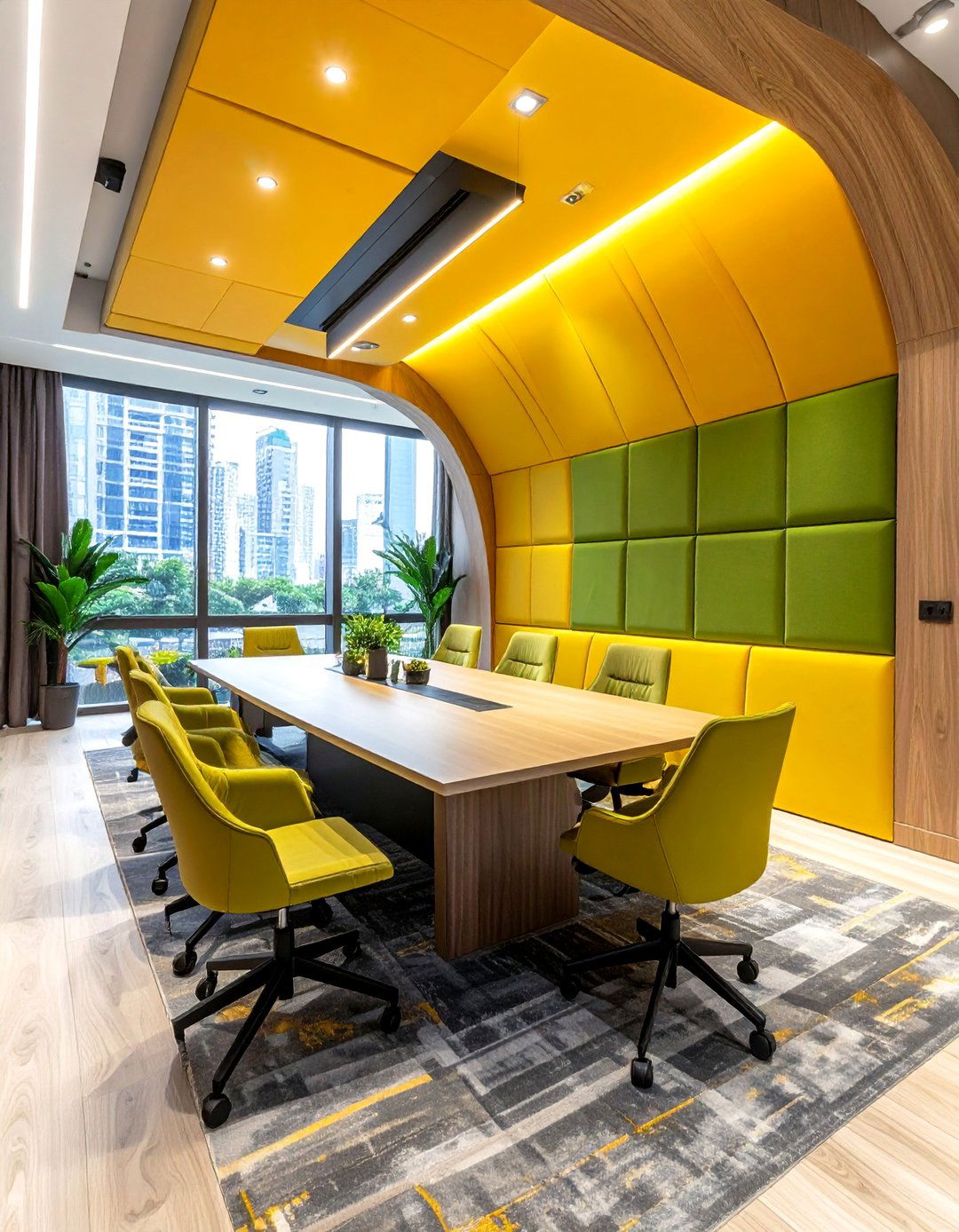
Could better sound quality be the key to more productive meetings? Acoustic-optimized conference rooms prioritize crystal-clear audio through strategic material choices, sound absorption panels, and noise control solutions. Fabric-wrapped acoustic panels on walls and ceilings reduce echo and reverberation while adding visual texture and color options that complement the overall design scheme. Carpet or acoustic flooring materials minimize footstep noise and chair movement sounds, while sound-masking systems provide consistent background noise that enhances speech privacy. Conference tables with built-in sound dampening features and chairs with acoustic properties contribute to the overall sound management strategy. Proper spacing between seating positions ensures optimal voice projection and hearing, while advanced microphone systems capture every voice clearly for remote participants. Windows feature acoustic glazing to block external noise, and HVAC systems use quiet operation modes during meetings. These design elements work together to create environments where every word is heard clearly, enabling more effective communication and reducing meeting fatigue.
9. Outdoor Conference Space Design
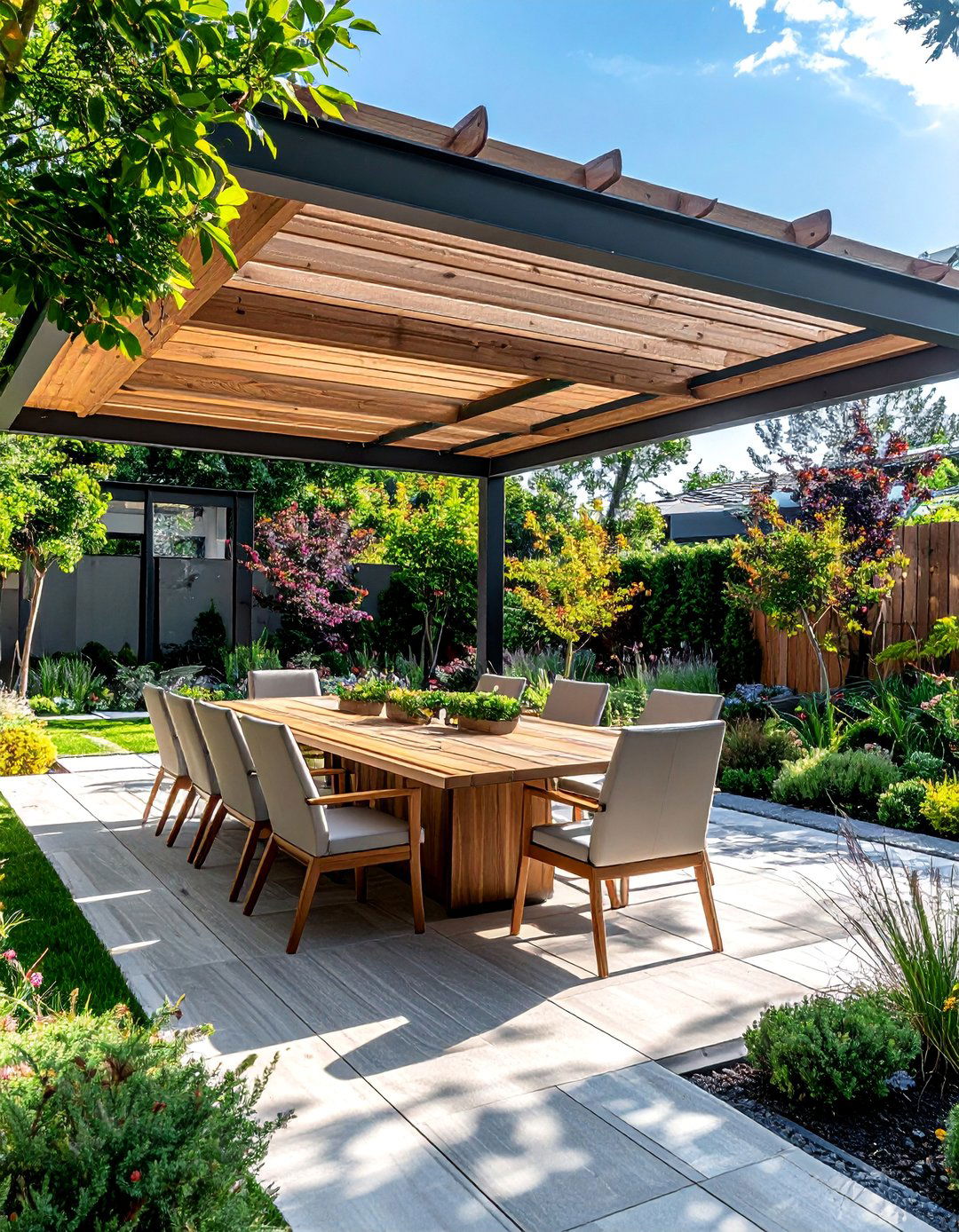
Why limit great ideas to indoor spaces when nature provides the perfect backdrop for innovation? Outdoor conference spaces extend meeting capabilities beyond traditional walls, featuring weather-resistant furniture, overhead protection, and technology solutions designed for exterior use. Pergolas, umbrellas, or covered pavilions provide shade and weather protection while maintaining the open-air experience that energizes participants. Teak or aluminum furniture withstands outdoor conditions while providing comfort and professional appearance, and outdoor-rated displays and audio systems enable presentations and video conferencing in natural settings. Landscaping with native plants creates natural boundaries and reduces noise from surrounding areas, while outdoor lighting extends usability into evening hours. Power solutions through weatherproof outlets or solar charging stations keep devices operational during extended sessions. The combination of fresh air, natural lighting, and garden or landscape views can significantly boost creativity and engagement levels, making outdoor spaces ideal for brainstorming sessions, team building activities, and client meetings that benefit from memorable and inspiring environments.
10. Cafe-Style Informal Conference Areas
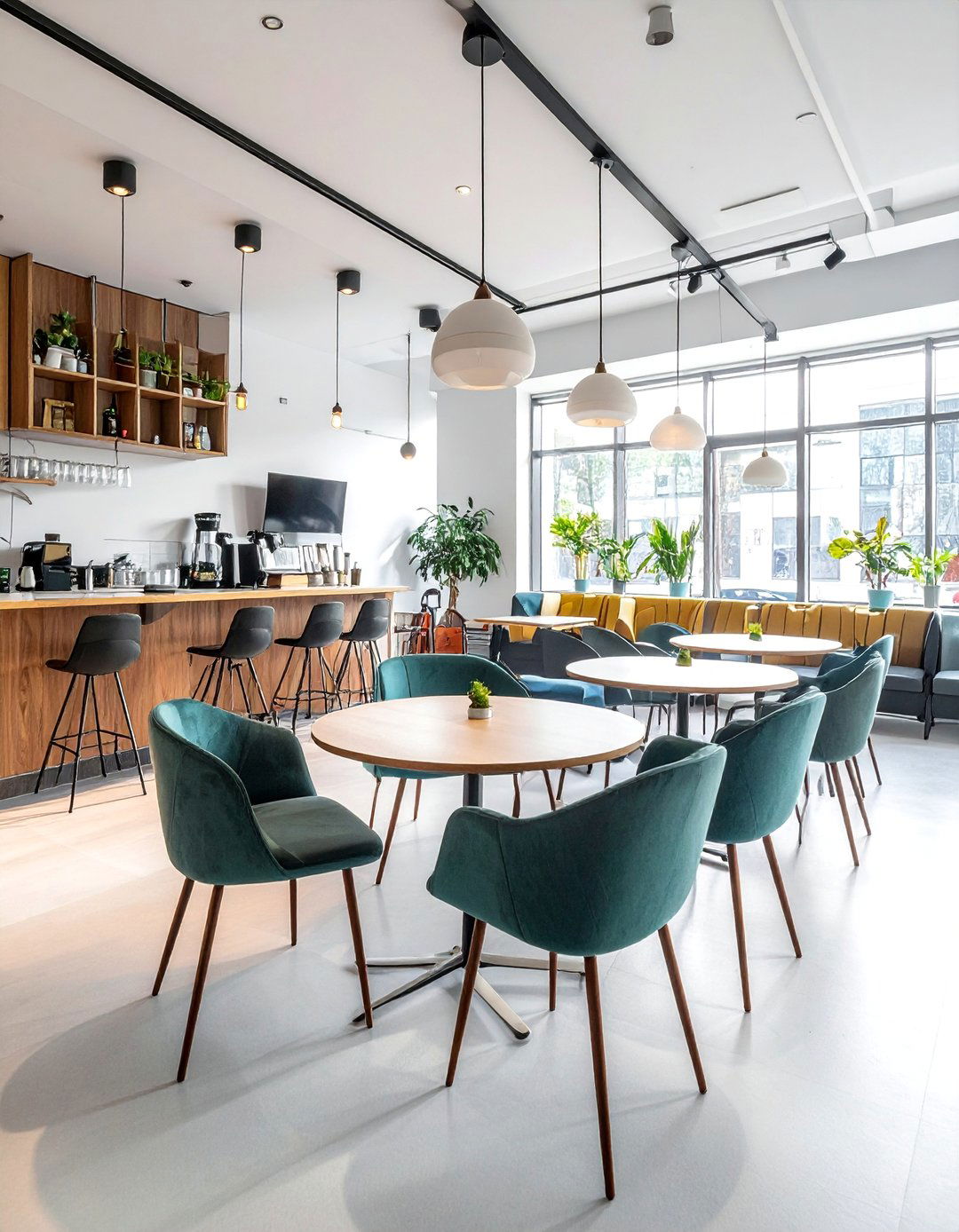
What if your most productive meetings happened over coffee in a relaxed setting? Cafe-style conference areas blend casual dining aesthetics with meeting functionality, creating approachable spaces that encourage open communication and creative thinking. High-top tables with bar stools provide standing meeting options that keep sessions brief and energetic, while comfortable lounge seating with coffee tables accommodates longer collaborative discussions. Coffee stations, beverage refrigerators, and snack areas support extended brainstorming sessions and provide natural conversation starters that help break down formal barriers. Warm lighting from pendant fixtures and table lamps creates intimate atmospheres different from traditional conference rooms, while acoustic treatment through soft furnishings and strategic layout prevents noise from disrupting nearby work areas. Local artwork, community bulletin boards, and plants add personality and warmth that makes these spaces feel welcoming and inspiring. These environments work particularly well for creative teams, client relationship building, and cross-departmental collaboration where informal interactions often lead to breakthrough innovations.
11. Glass-Walled Transparent Conference Rooms
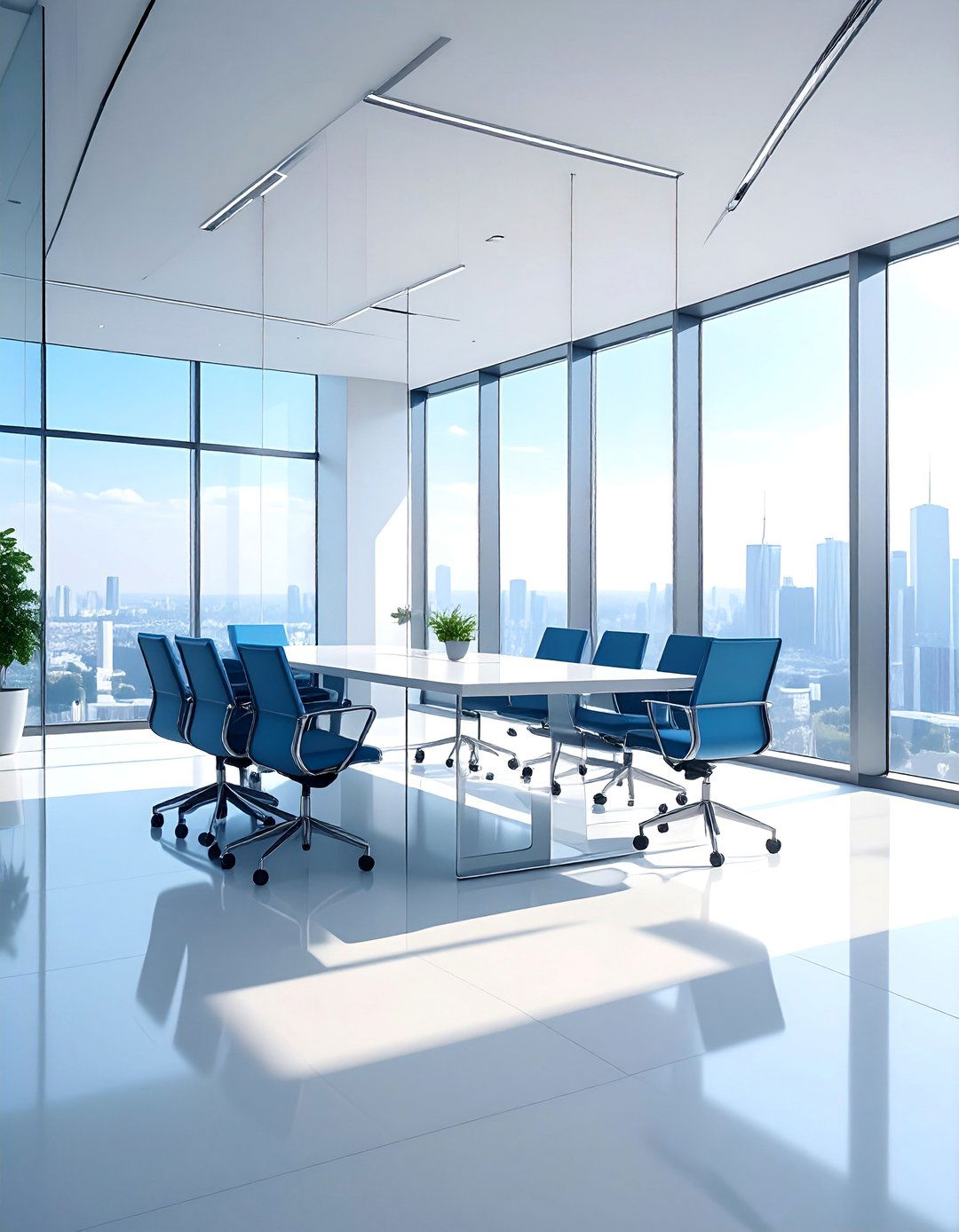
How does visual openness change the dynamics of team collaboration? Glass-walled conference rooms maintain transparency and visual connection with the broader workplace while providing necessary acoustic separation for focused discussions. Floor-to-ceiling glass panels create the illusion of larger spaces and allow natural light to flow throughout the office, while switchable smart glass provides instant privacy when confidential matters require discretion. The transparent design encourages accountability and reduces the intimidation factor often associated with closed-door meetings, making these spaces feel more accessible and inclusive. Minimal furniture and clean lines emphasize the openness concept, with sleek tables and modern chairs that complement the contemporary aesthetic. Strategic placement of acoustic treatments ensures sound privacy without compromising the visual transparency that defines these spaces. Technology integration includes wireless presentation capabilities and video conferencing systems that work seamlessly with the open design concept, creating environments where collaboration feels natural and spontaneous rather than formal and restrictive.
12. Technology Integration Conference Room Features

Are your meetings limited by outdated technology or empowered by seamless digital tools? Technology-integrated conference rooms feature cutting-edge equipment and smart systems that eliminate technical barriers and enhance collaboration efficiency. Large 4K displays or projection systems provide crystal-clear visuals for presentations and video conferences, while wireless screen sharing eliminates cable connections and supports multiple device types simultaneously. Advanced camera systems with AI-powered tracking ensure remote participants can see and hear everything clearly, and distributed microphone arrays capture voices from every seat with professional audio quality. Automated lighting systems adjust based on presentation needs and time of day, while climate controls maintain optimal comfort throughout extended meetings. Interactive whiteboards and digital collaboration tools enable real-time brainstorming and document sharing, and integrated scheduling systems display room availability and upcoming meetings. These technological features work invisibly in the background, allowing participants to focus on content and collaboration rather than troubleshooting equipment issues that can derail productive discussions.
13. Sustainable Eco-Friendly Conference Room Design
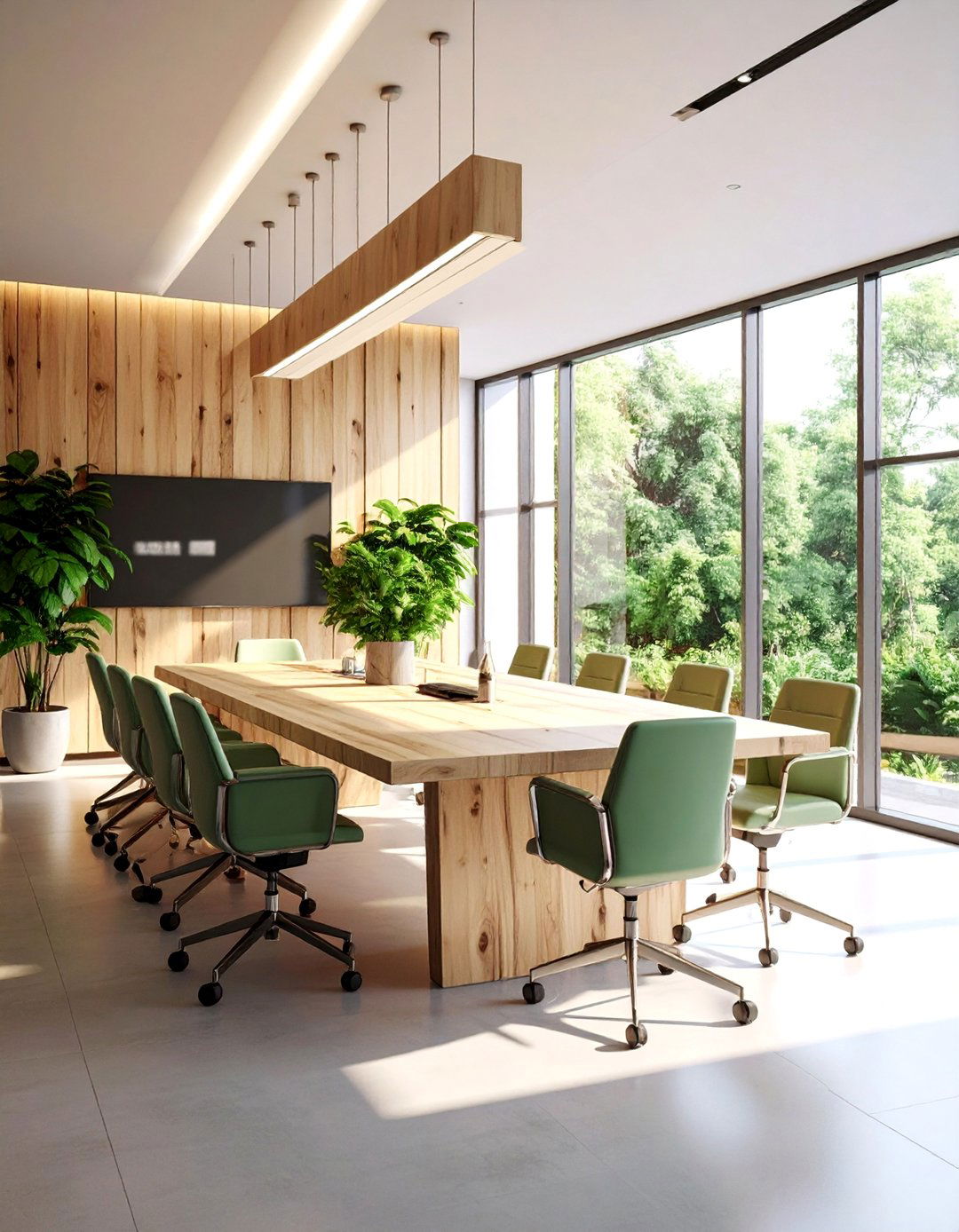
Could your meeting space contribute to environmental goals while inspiring sustainable thinking? Eco-friendly conference rooms showcase environmental responsibility through sustainable materials, energy-efficient systems, and biophilic design elements that connect occupants with nature. Reclaimed wood furniture, recycled content carpeting, and low-VOC finishes create healthy indoor environments while reducing environmental impact. Energy-efficient LED lighting with daylight sensors minimizes power consumption, while smart HVAC systems optimize air quality and temperature control. Living walls and abundant plants improve air quality naturally while providing calming green elements that reduce stress and enhance creativity. Furniture made from sustainable materials like bamboo or recycled plastics demonstrates environmental commitment, while water-efficient fixtures and renewable energy systems further reduce the ecological footprint. These design choices often become conversation starters that reinforce organizational values and inspire participants to consider sustainability in their business decisions, creating spaces where environmental consciousness enhances rather than restricts productive collaboration and innovative thinking.
14. Color Psychology Conference Room Schemes
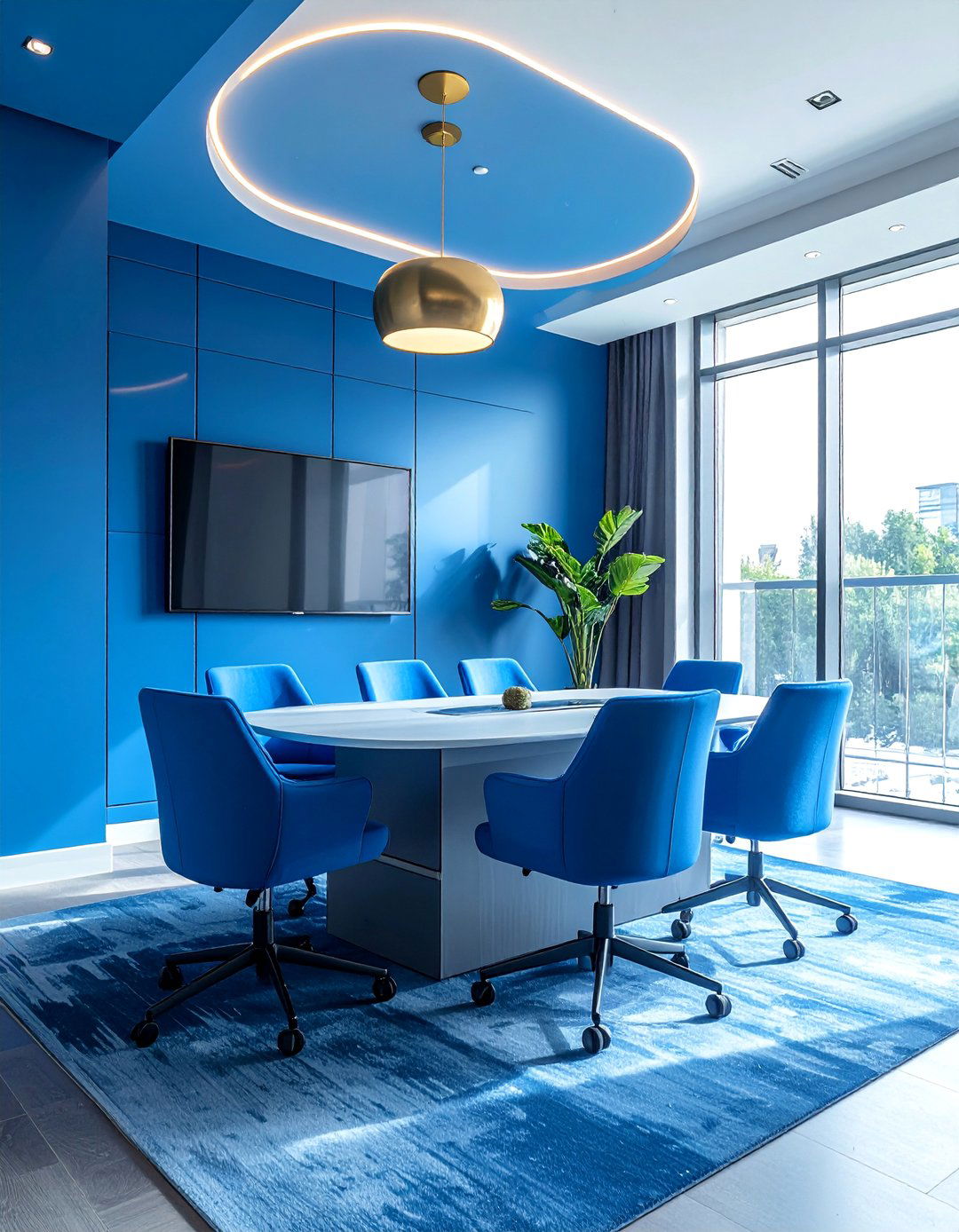
What emotional responses do your meeting room colors trigger in participants? Color psychology-based conference rooms use specific color schemes to influence mood, energy levels, and productivity during different types of meetings and collaborative sessions. Blue tones promote focus and analytical thinking, making them ideal for strategic planning and problem-solving meetings, while green schemes reduce stress and encourage creative thinking during brainstorming sessions. Warm colors like orange and yellow energize participants and stimulate discussion, perfect for team building and ideation meetings, while neutral grays and whites provide calming environments for conflict resolution and detailed negotiations. Red accents can increase urgency and decision-making speed when used sparingly, and purple tones often inspire innovation and creative thinking. The key lies in matching color choices to intended meeting purposes and organizational culture, creating environments that subconsciously support desired outcomes. Proper lighting design enhances color impact while ensuring colors appear true and consistent throughout different times of day, maximizing the psychological benefits that thoughtful color selection can provide.
15. Multi-Purpose Convertible Conference Spaces

Why dedicate valuable real estate to single-use rooms when spaces can transform to meet changing needs? Multi-purpose conference spaces feature flexible design elements that enable quick conversion between meeting room, training facility, social space, and presentation auditorium. Moveable furniture on wheels allows rapid reconfiguration, while retractable projection screens and mobile technology carts provide audio-visual capabilities wherever needed. Modular seating systems stack and store efficiently, and folding tables create various layout options from classroom style to reception setup. Acoustic treatments include moveable panels that adjust sound characteristics for different uses, while flexible lighting systems accommodate everything from intimate meetings to large presentations. Storage solutions integrated into walls or mobile units keep conversion supplies organized and accessible, making space transformation quick and efficient. Color schemes and materials remain neutral enough to work with various setup configurations while maintaining professional appearance throughout all uses. These versatile environments maximize space utilization while providing organizations with adaptable infrastructure that grows and changes with evolving business needs.
16. Wellness-Focused Conference Room Design
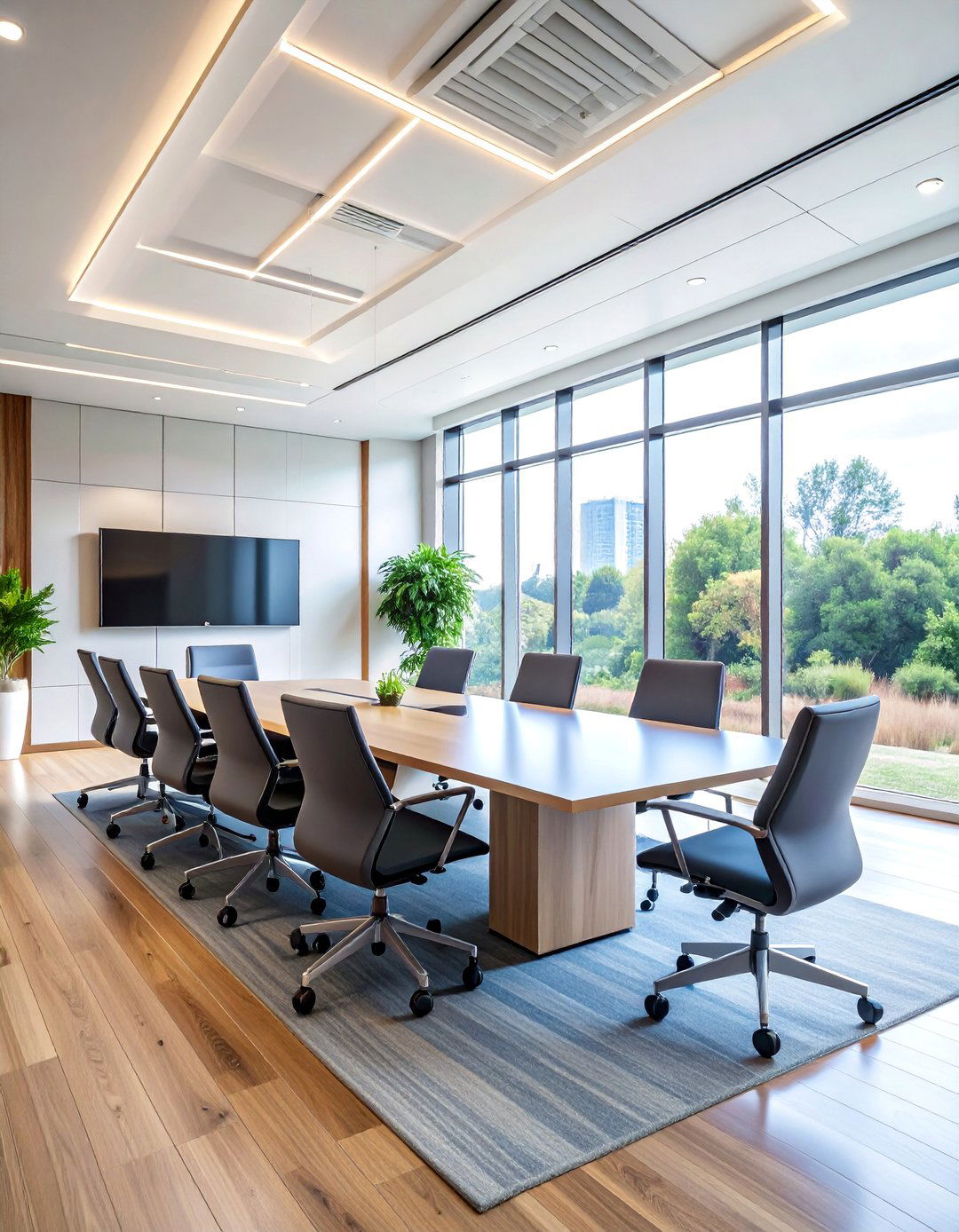
How can meeting spaces actively contribute to participant health and well-being? Wellness-focused conference rooms prioritize physical and mental health through ergonomic furniture, air quality management, and stress-reducing design elements that support sustained productivity. Sit-stand desks and adjustable-height tables accommodate different postures and movement preferences, while ergonomic chairs provide proper support for extended meetings. Air purification systems and abundant plants ensure optimal air quality, and circadian lighting systems adjust color temperature throughout the day to support natural rhythms. Acoustic design minimizes stress-inducing noise, while temperature controls maintain optimal comfort zones that prevent fatigue and distraction. Hydration stations and healthy snack options support physical wellness, and meditation or quiet zones provide stress relief opportunities during breaks. Natural materials, calming colors, and views of nature or artwork contribute to psychological well-being, creating environments where participants feel energized rather than drained by extended collaborative sessions. These design elements recognize that productive meetings require healthy, comfortable participants who can focus fully on the tasks at hand.
17. Creative Studio Conference Room Layout

Can conference rooms inspire breakthrough thinking through artistic and unconventional design approaches? Creative studio conference rooms break traditional meeting room conventions with artistic layouts, inspirational elements, and flexible spaces that encourage innovative thinking and artistic expression. Easels, whiteboards, and writable wall surfaces provide multiple canvases for idea development, while art supplies and creative tools remain easily accessible for hands-on brainstorming. Casual seating options include bean bags, floor cushions, and lounge chairs arranged in conversation clusters rather than formal rows, and moveable furniture allows spontaneous reconfiguration as ideas develop. Inspiring artwork, motivational quotes, and examples of successful creative projects line the walls, while varied lighting options from bright task lighting to mood lighting support different types of creative work. Sound systems enable music that can enhance creativity when appropriate, and informal elements like game tables or relaxation areas provide mental breaks that often lead to breakthrough insights. These environments work particularly well for advertising agencies, design firms, and innovation teams that need spaces specifically designed to stimulate creative thinking and artistic collaboration.
18. Hybrid Work Conference Room Solutions
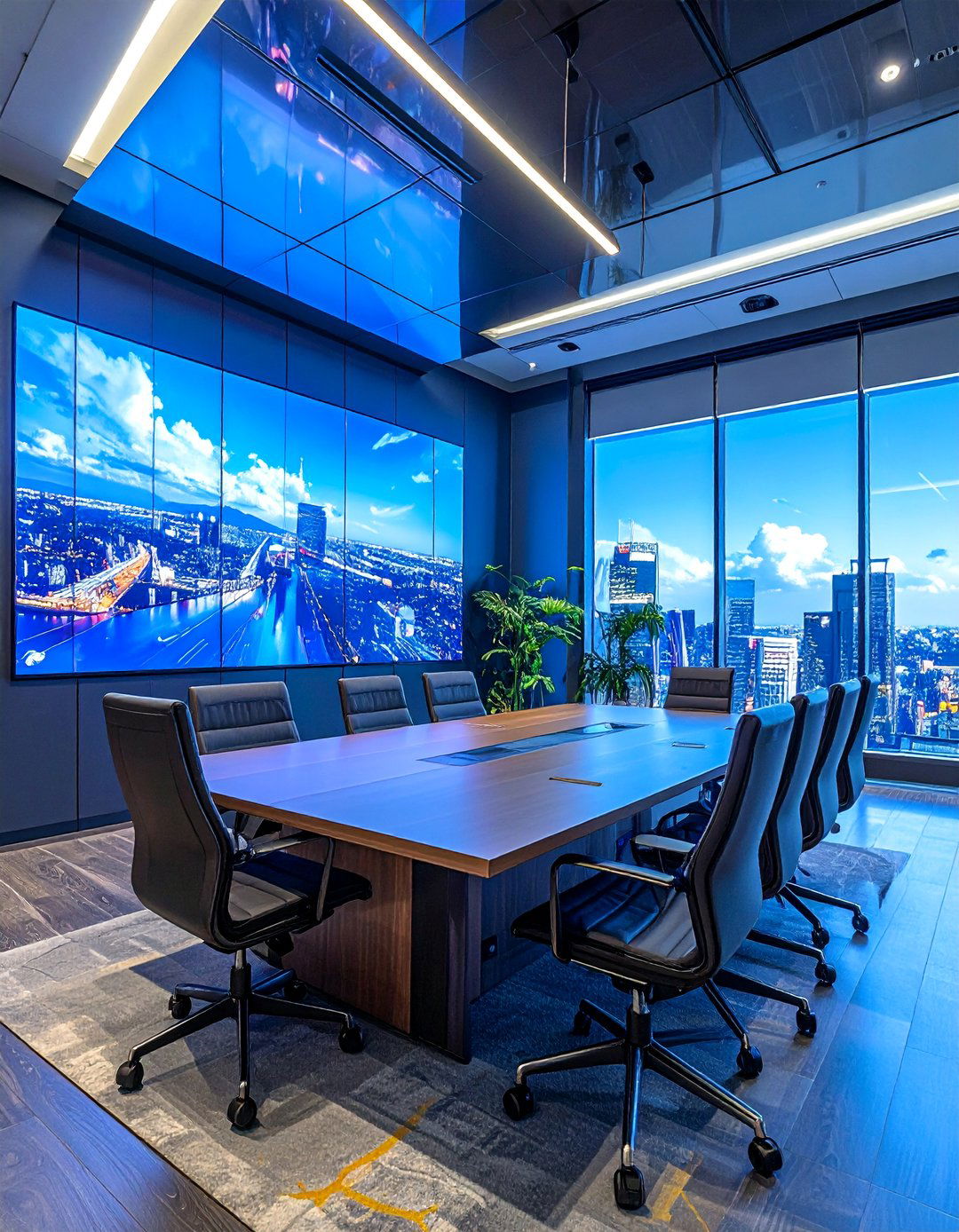
How do you create equally engaging experiences for both in-person and remote meeting participants? Hybrid work conference rooms feature specialized technology and design elements that eliminate the traditional divide between on-site and virtual attendees. Multiple high-definition cameras capture different room angles and speaker close-ups, while distributed microphone systems ensure every voice reaches remote participants clearly. Large displays show remote attendees at life-size scales, and separate screens provide shared content viewing that mirrors what in-person participants see. Lighting design eliminates shadows and glare that can impair video quality, while acoustic treatments optimize audio for both room occupants and digital transmission. Seating arrangements consider camera angles and ensure all participants appear prominently in video feeds, and interactive whiteboards and digital collaboration tools enable real-time sharing that engages both audience types simultaneously. Advanced software integration supports seamless content sharing, recording, and follow-up distribution, creating meeting experiences where location becomes irrelevant to participation quality and collaborative effectiveness that drives business results.
19. Luxury Executive Conference Room Design
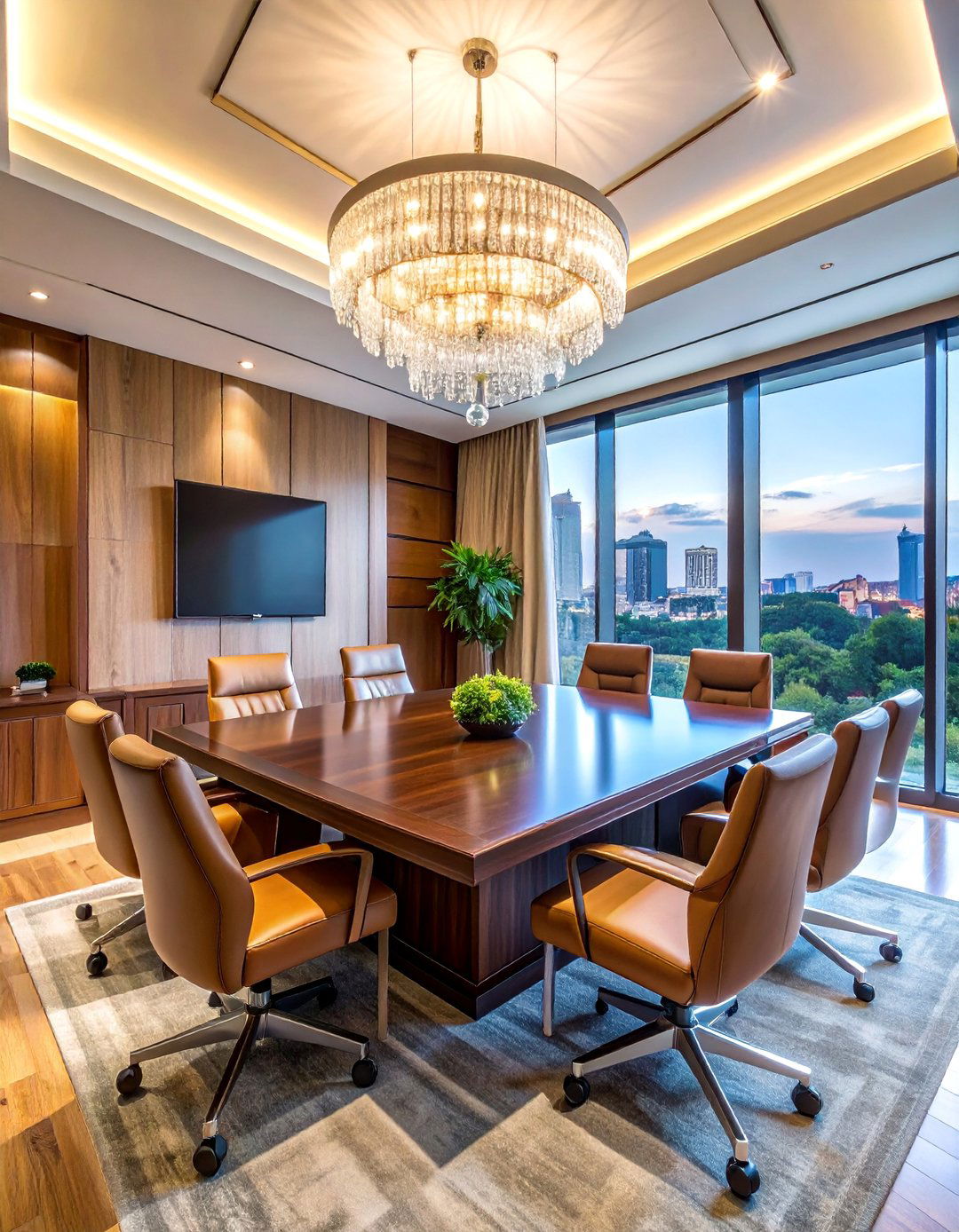
What design elements communicate prestige while facilitating high-stakes business discussions? Luxury executive conference rooms combine premium materials, sophisticated furnishings, and refined details that reflect organizational success and command respect from clients and stakeholders. Handcrafted wooden conference tables in exotic woods create stunning centerpieces, paired with Italian leather chairs that provide comfort and elegance during extended strategic sessions. Crystal chandeliers or custom lighting fixtures provide dramatic illumination, while original artwork and museum-quality pieces demonstrate cultural sophistication. Rich fabrics, custom millwork, and architectural details like coffered ceilings or decorative moldings add layers of visual interest and craftsmanship. Advanced technology remains discretely integrated to maintain the elegant aesthetic, while climate control and acoustic systems operate silently to preserve the refined atmosphere. Persian rugs, fresh flowers, and premium finishes throughout create environments where important business relationships develop and significant decisions receive the gravitas they deserve through settings that inspire confidence and communicate success.
20. Acoustic Pod Conference Room Design

Could intimate enclosed spaces revolutionize how small teams collaborate and communicate? Acoustic pod conference rooms provide private, soundproof environments within open office spaces, offering phone booth-style enclosures that accommodate two to four participants for confidential discussions. Advanced acoustic engineering blocks external noise while preventing internal conversations from disturbing surrounding work areas, creating islands of privacy in busy environments. Comfortable seating and compact tables provide workspace for laptops and documents, while integrated technology supports video calls and presentations within the confined space. Proper ventilation systems maintain air quality and comfort in enclosed environments, and strategic lighting ensures adequate illumination without creating glare or shadows. Ergonomic design considers sight lines and personal space requirements within limited square footage, while easy entry and exit accommodate quick impromptu meetings and scheduled sessions. These pods often feature modern materials like fabric panels, wood accents, and glass elements that complement contemporary office aesthetics while delivering functional acoustic separation that enables focused collaboration without geographic displacement from the broader team environment.
21. Conference Room Lighting Design Solutions

How does lighting influence energy levels, focus, and the overall success of collaborative meetings? Strategic conference room lighting combines natural daylight, task lighting, and ambient illumination to create optimal visual environments for different meeting types and times of day. Large windows with automated blinds provide natural light control while maintaining views that enhance mood and reduce feelings of confinement during extended sessions. LED panel systems offer adjustable brightness and color temperature that supports circadian rhythms and reduces eye strain during screen-intensive presentations. Task lighting over work surfaces ensures document reading and note-taking remain comfortable, while accent lighting highlights architectural features and artwork that contribute to the room's professional atmosphere. Dimmable controls allow adjustment for video conferencing, presentation viewing, and various meeting activities, and automated systems adjust lighting based on occupancy and time of day. Proper lighting design eliminates glare and shadows that can impair communication, while creating visual environments that keep participants alert, engaged, and comfortable throughout meetings of any duration or complexity level.
22. Small Space Conference Room Optimization

What strategies maximize functionality and comfort when square footage is at a premium? Small space conference rooms require careful planning and creative solutions that provide full meeting capabilities within limited physical boundaries and constrained layouts. Wall-mounted displays eliminate floor space requirements while providing presentation capabilities, and folding or nesting furniture allows quick storage when rooms serve multiple purposes. Built-in storage solutions maximize vertical space utilization, while light colors and mirrors create illusions of larger dimensions that prevent feelings of claustrophobia. Strategic acoustic treatment ensures privacy without consuming valuable wall space, and technology integration includes wireless systems that eliminate cable clutter. Compact furniture scaled appropriately for the room size maintains comfort without overwhelming the space, and efficient traffic flow patterns ensure easy access and exit. Natural light and views to outdoor spaces help small rooms feel connected to larger environments, while clever storage keeps meeting supplies organized and accessible. These optimization strategies prove that size limitations need not restrict meeting effectiveness when thoughtful design maximizes every available square foot for productive collaborative use.
23. Brand-Focused Conference Room Identity
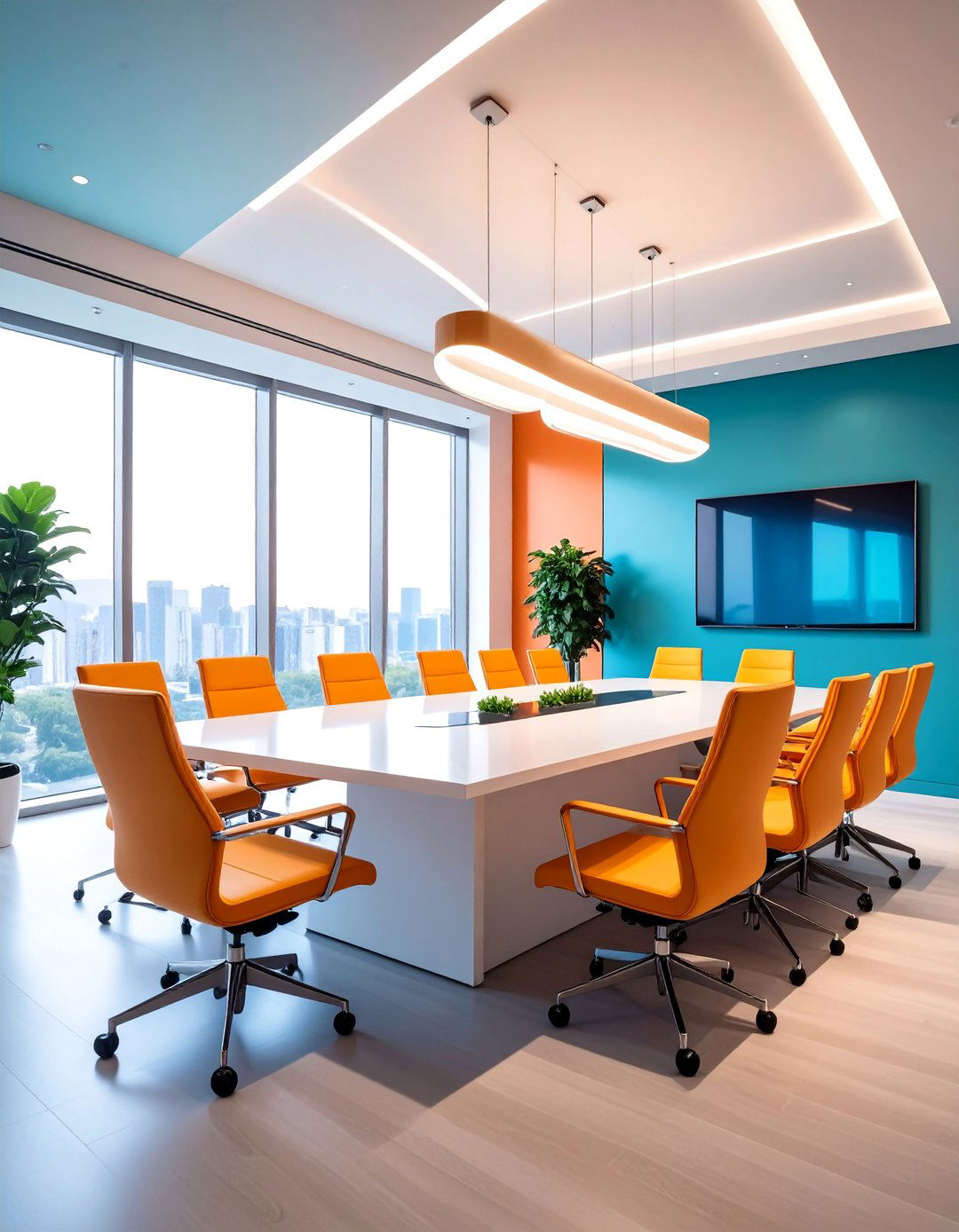
How can meeting spaces reinforce company culture while creating memorable experiences for clients and employees? Brand-focused conference rooms incorporate organizational colors, logos, values, and personality traits into cohesive design schemes that strengthen identity and create distinctive environments. Company colors appear in furniture, artwork, and accent elements that reinforce brand recognition, while custom graphics and branded elements communicate corporate messaging. Mission statements, core values, and company history displays remind participants of organizational purpose and direction, and product showcases or achievement highlights demonstrate success and capability. Furniture styles and material choices reflect brand personality, whether traditional and conservative or modern and innovative, and lighting design supports the desired emotional response to brand interaction. Awards, client testimonials, and industry recognition provide credibility and conversation starters that enhance business relationships, while cultural artifacts and employee achievements celebrate organizational community. These branded environments become powerful tools for employee engagement and client impression management, creating spaces where company identity enhances rather than distracts from productive business discussions and relationship building activities that drive organizational success forward.
24. Interactive Technology Conference Room Features

What possibilities emerge when meeting spaces become interactive digital environments? Interactive technology conference rooms feature touch-enabled surfaces, gesture controls, and collaborative digital tools that transform how teams share ideas and work together. Interactive whiteboards allow multiple simultaneous users to draw, write, and manipulate content in real-time, while touch-enabled tables provide shared digital workspaces for document review and collaborative editing. Gesture-controlled presentation systems enable hands-free navigation through content, and voice recognition allows natural interaction with room systems and digital assistants. Augmented reality capabilities overlay digital information onto physical spaces, while virtual reality systems enable immersive experiences for design reviews and remote collaboration. Multiple device connectivity allows seamless content sharing from any participant's personal technology, and cloud integration ensures all meeting content remains accessible after sessions end. These interactive features encourage active participation from all attendees while eliminating traditional barriers between digital content and physical discussion, creating engaging environments where technology enhances rather than complicates collaborative processes and innovative thinking.
25. Flexible Furniture Conference Room Arrangements
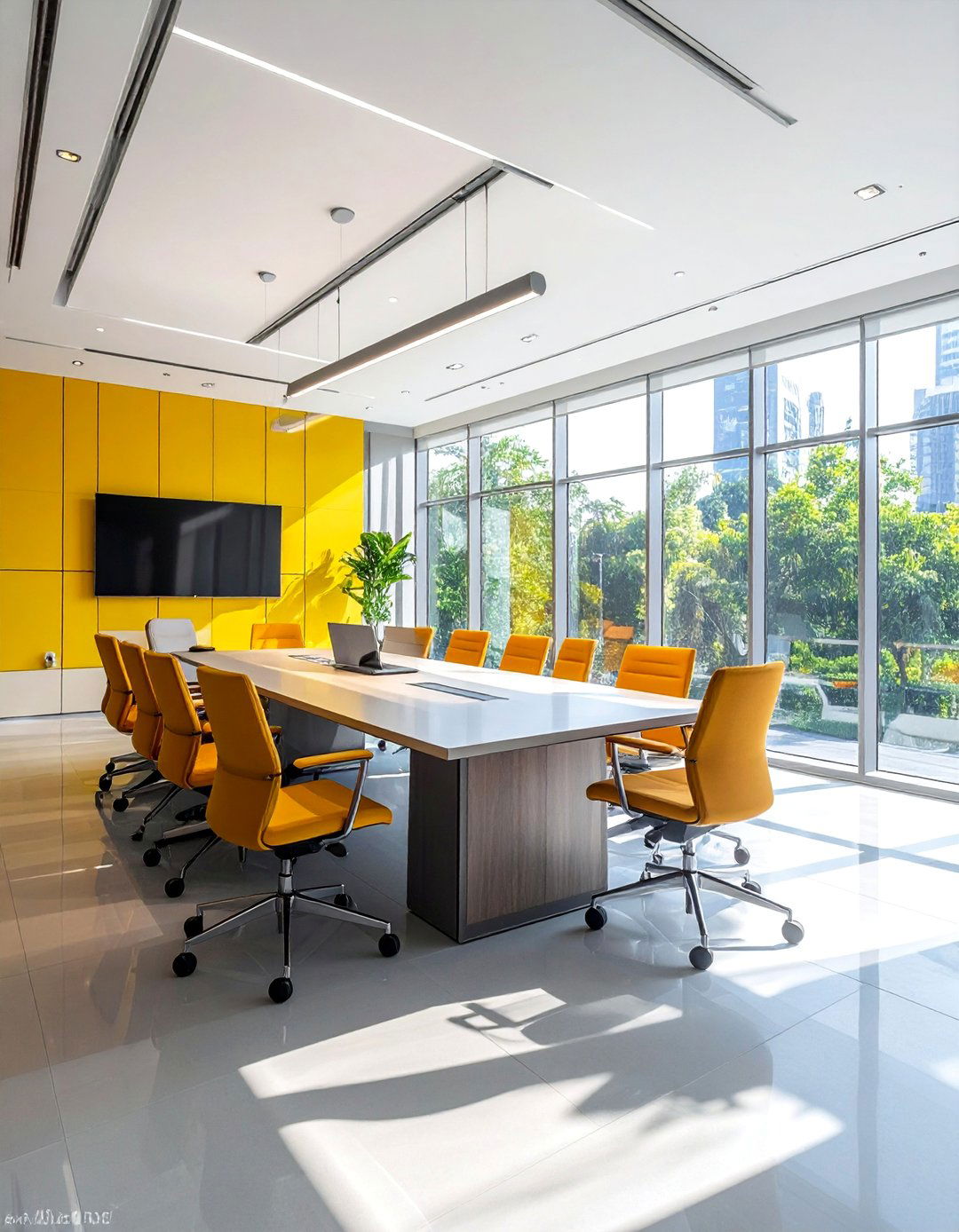
Why limit meeting effectiveness to rigid furniture arrangements when flexible systems adapt to any collaborative need? Flexible furniture conference rooms feature modular, moveable, and multi-functional pieces that transform spaces instantly for different meeting types, group sizes, and collaborative activities. Rolling tables and stackable chairs enable quick transitions between boardroom meetings, workshop sessions, and presentation formats, while modular seating pods create various conversation arrangements from intimate circles to large group configurations. Height-adjustable tables accommodate both sitting and standing meetings, and nesting furniture stores efficiently when maximum floor space is needed for activities or large groups. Mobile whiteboards and presentation displays move wherever needed, while rolling storage units provide supplies and equipment access throughout different room configurations. Lightweight materials and smooth-rolling casters make furniture movement effortless for users, and color-coding or labeling systems help teams quickly identify and arrange elements for specific purposes. These flexible arrangements maximize space utilization while ensuring every meeting type receives optimal furniture support that enhances rather than restricts collaborative effectiveness and participant comfort.
Conclusion:
The future of conference room design lies in creating spaces that adapt to evolving workplace needs while supporting human well-being and productivity. From intimate huddle rooms that encourage spontaneous collaboration to technology-rich environments that seamlessly connect global teams, successful conference rooms balance functionality with inspiration. The most effective designs incorporate biophilic elements that reduce stress, acoustic solutions that ensure clear communication, and flexible layouts that accommodate diverse meeting styles. Whether pursuing minimalist elegance, sustainable practices, or brand-focused identity, the key is alignment between design choices and organizational goals. As hybrid work continues to reshape how teams collaborate, conference rooms must evolve beyond simple meeting spaces to become dynamic environments that foster innovation, strengthen relationships, and drive business success through thoughtful design that prioritizes both human needs and technological capabilities for maximum collaborative impact.

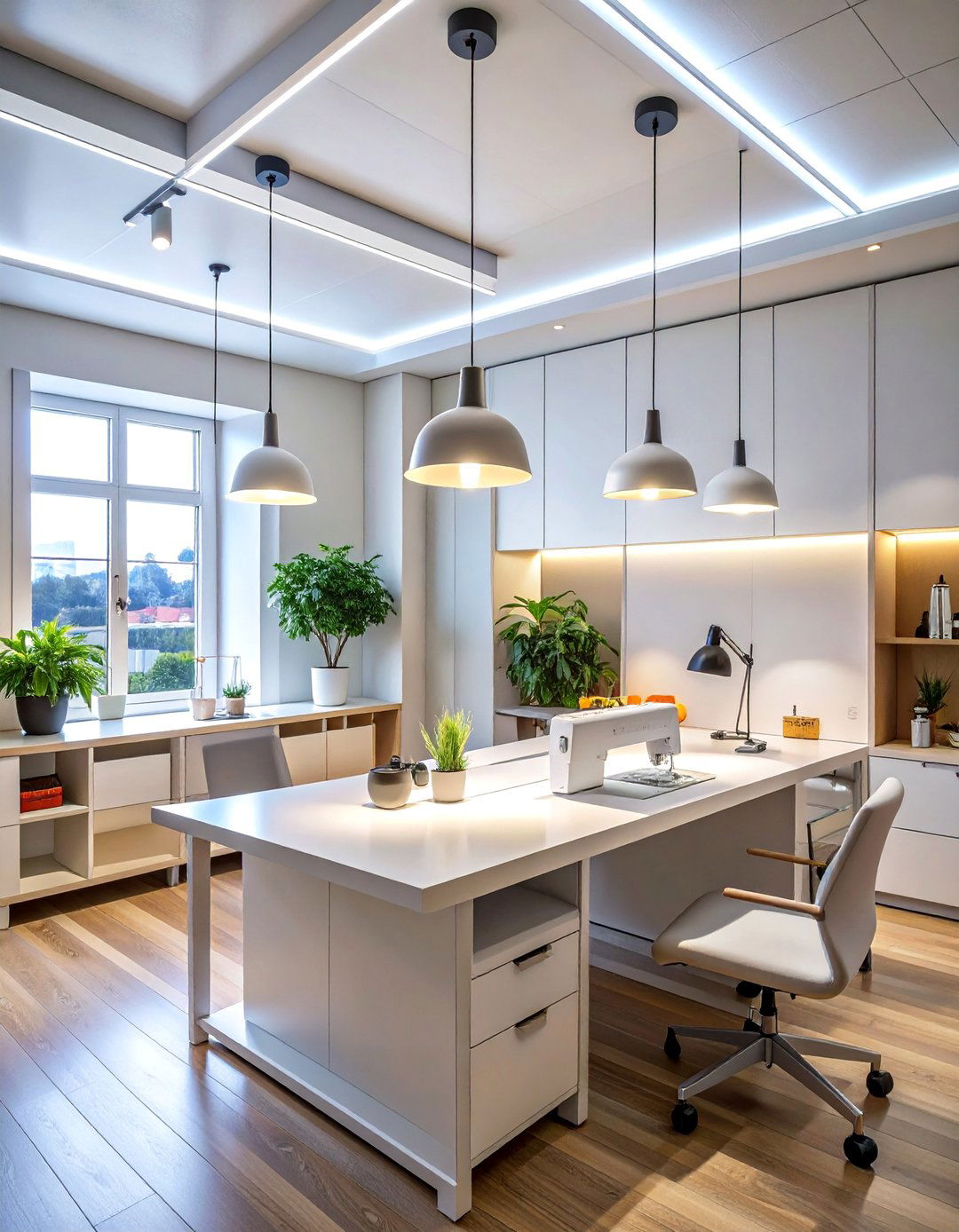
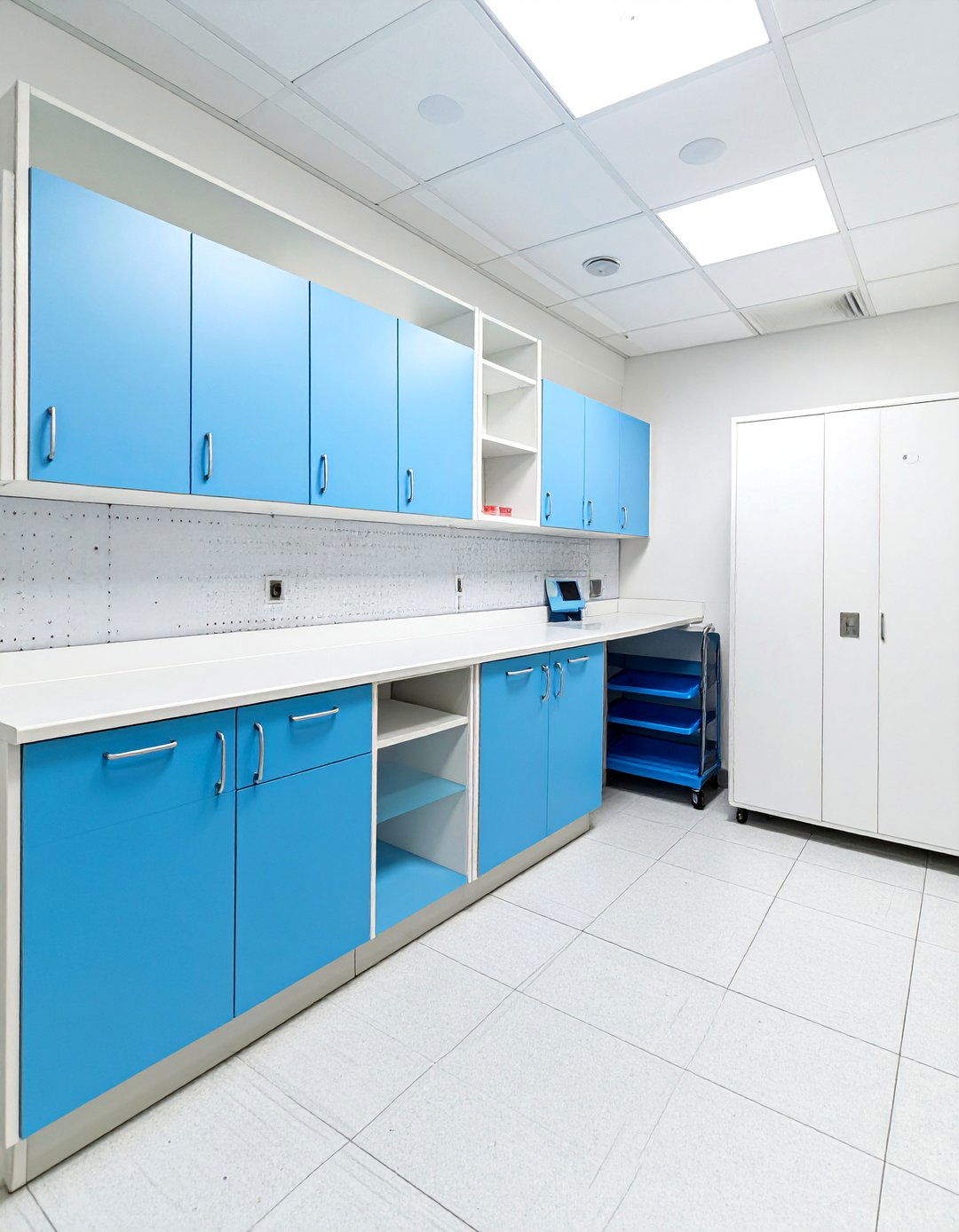
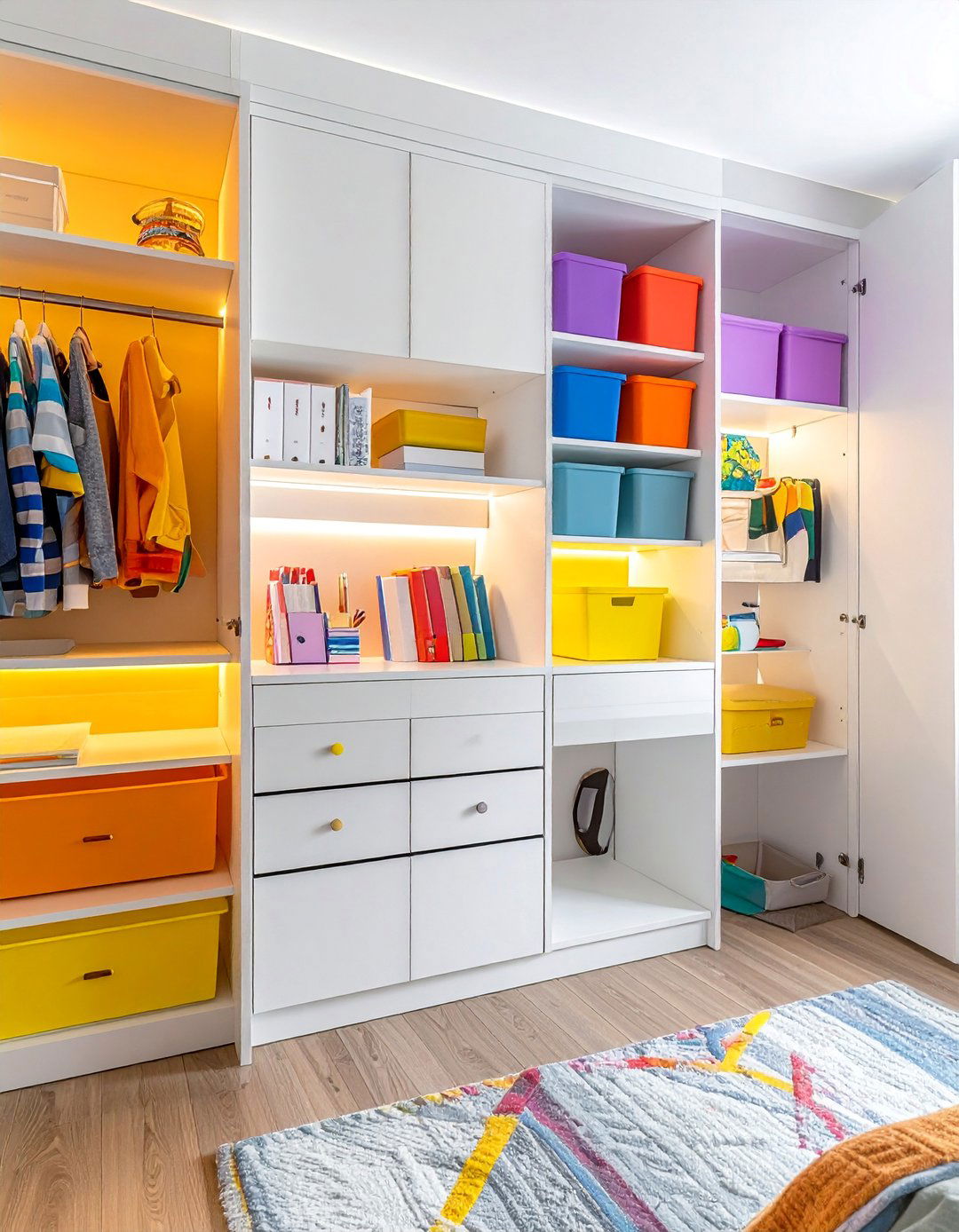
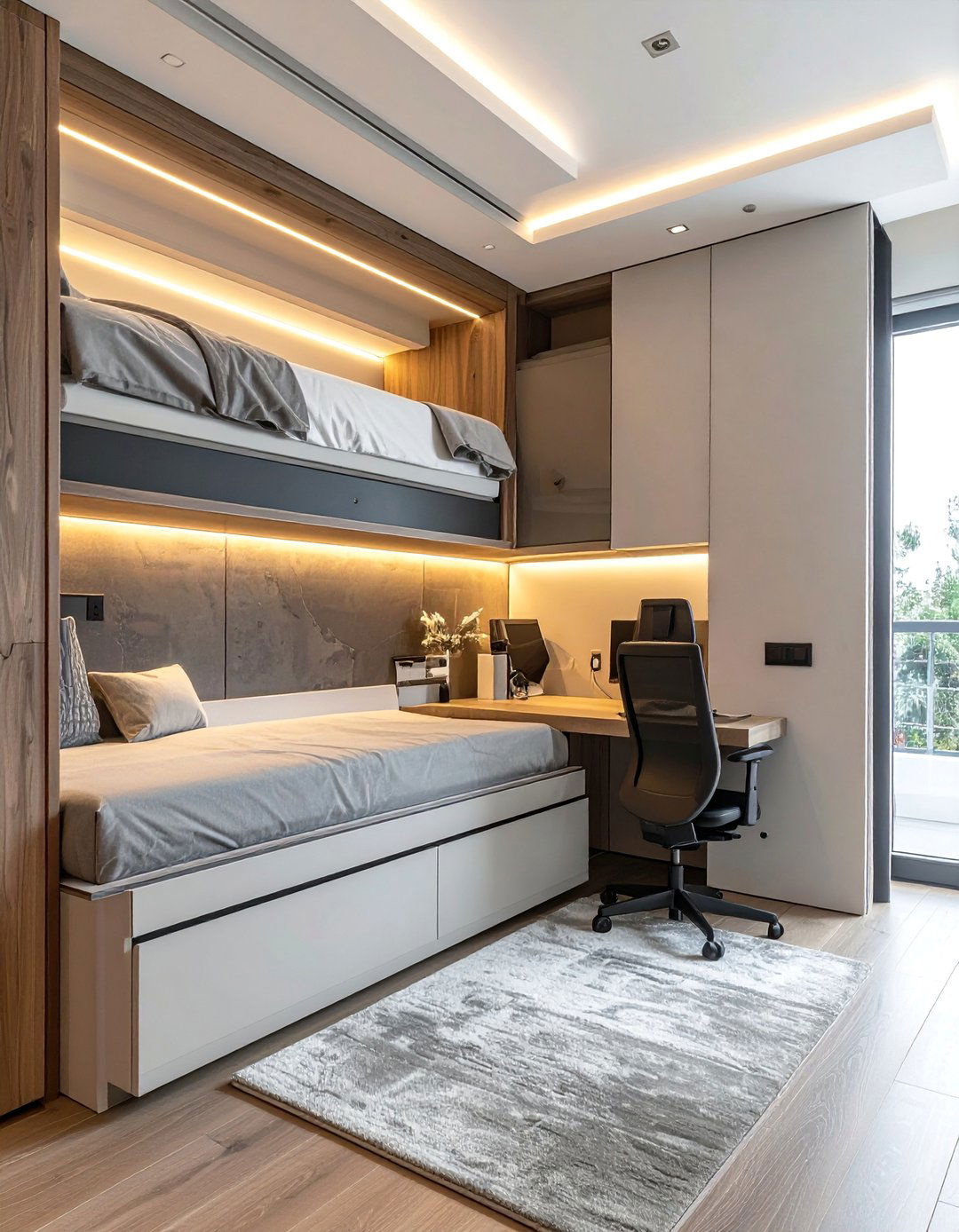

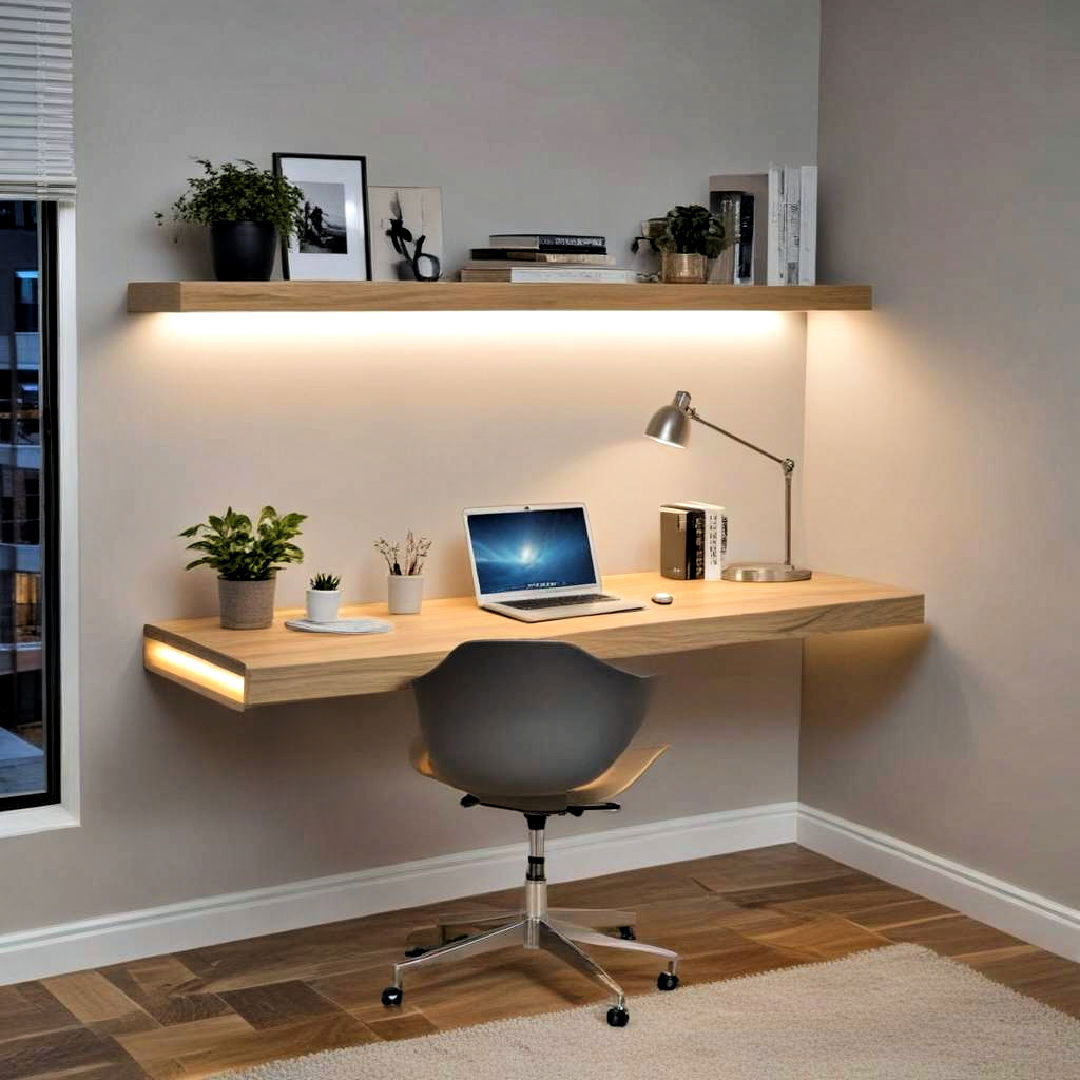
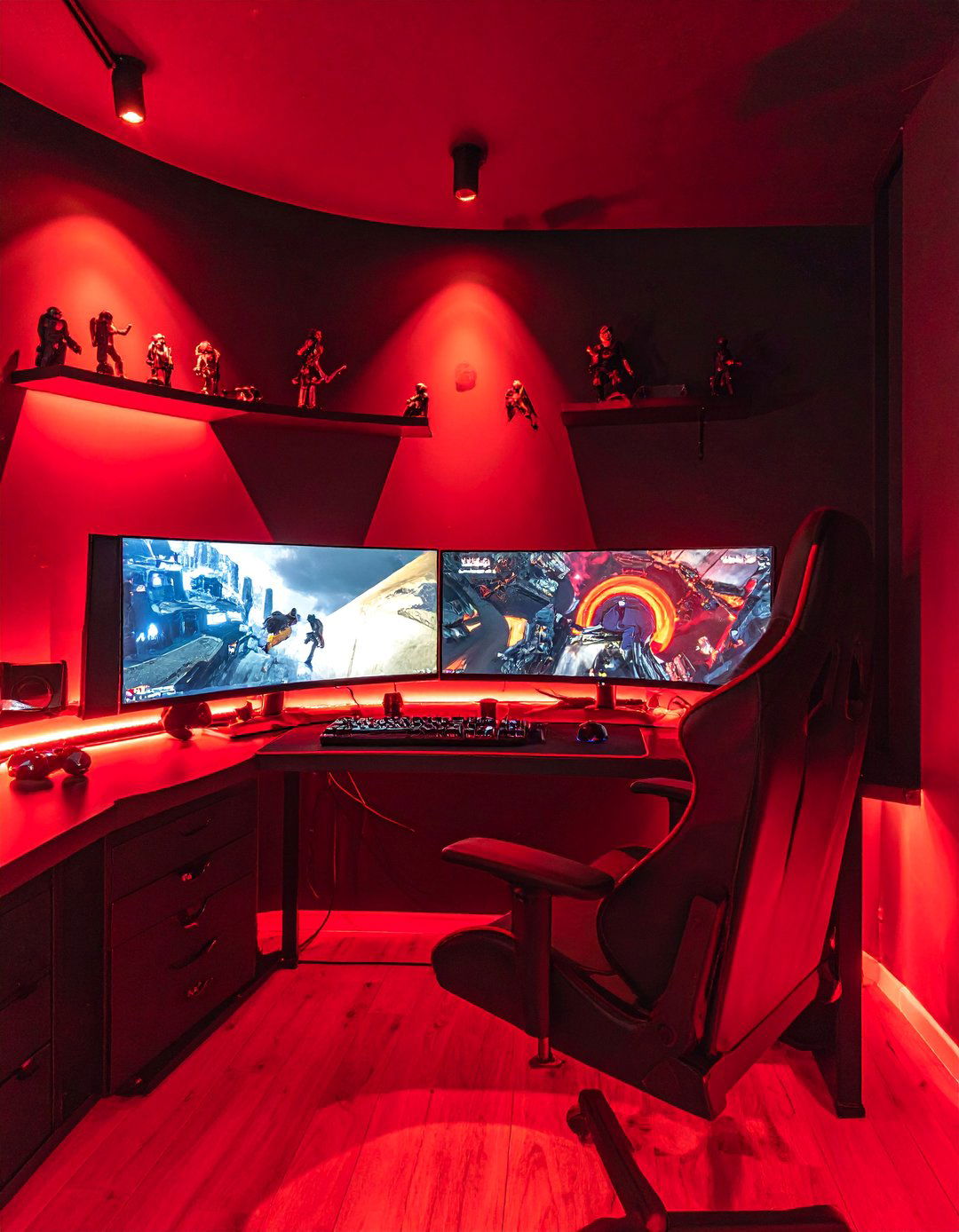
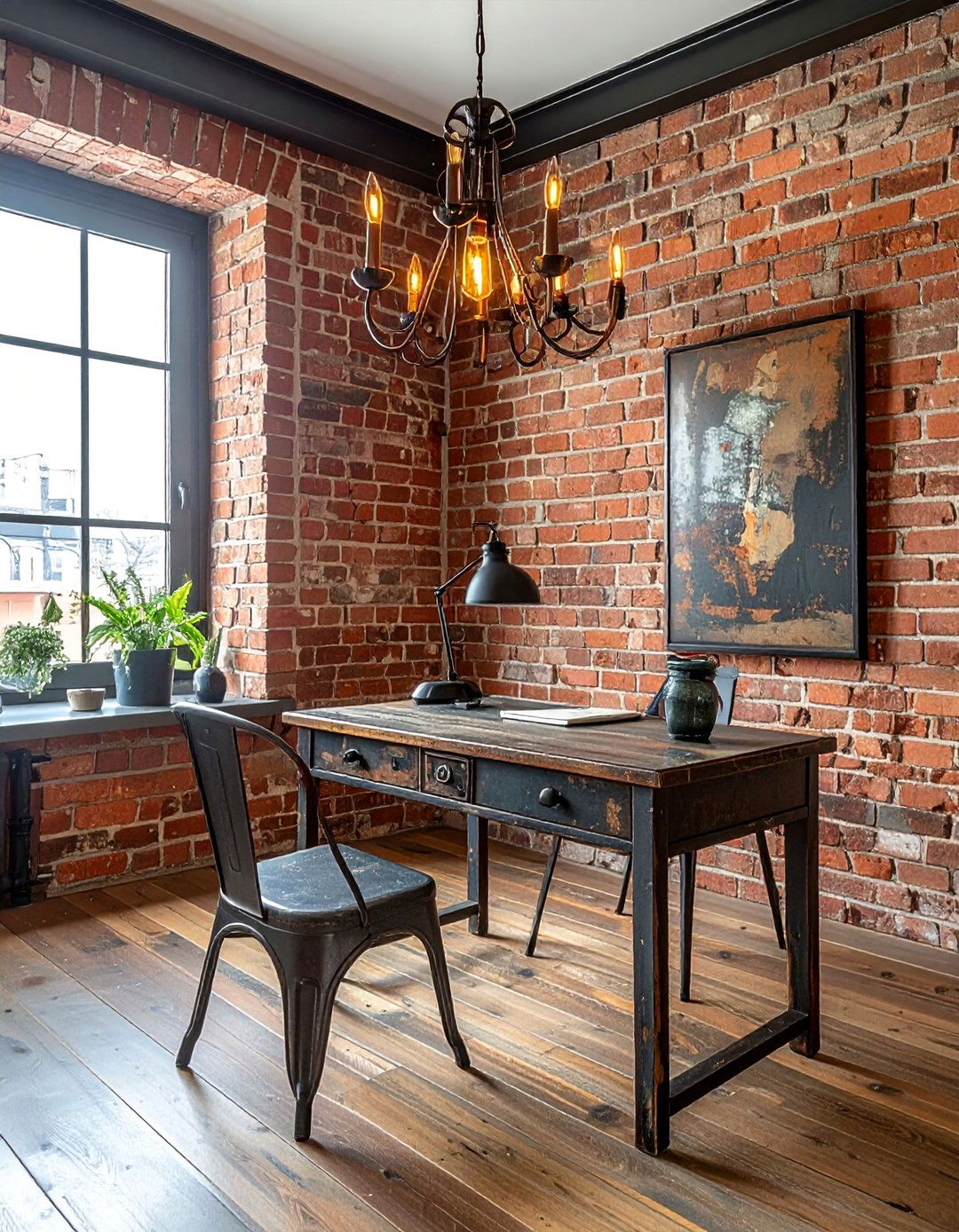
Leave a Reply